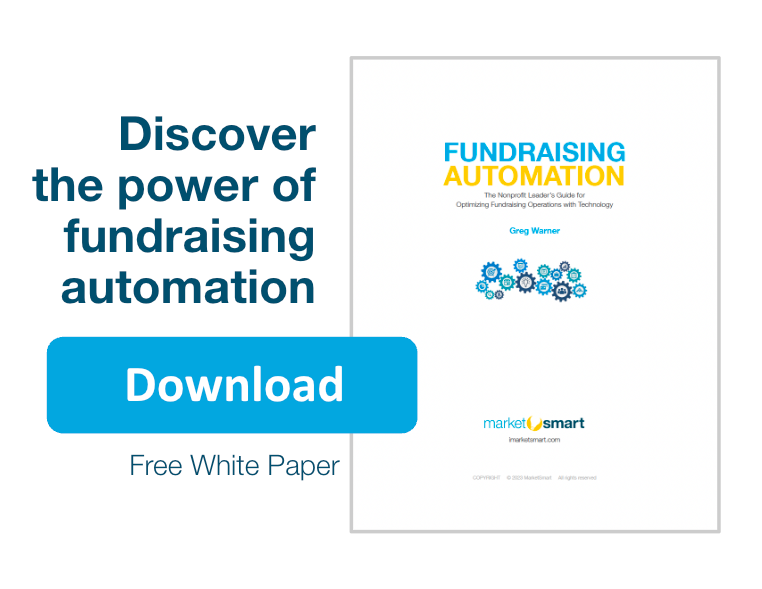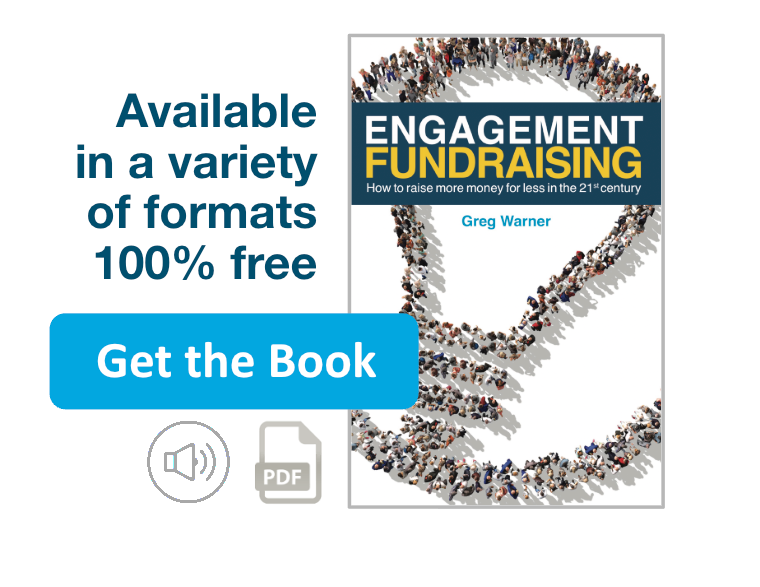I’m getting really tired of hearing people complain about donor advised funds.
For instance, it was reported by the Chronicle of Philanthropy that dollars put into DAF’s grew by 300% in the past 6 years compared to just a 13% increase in charitable giving during the same period.
But here’s one thing that is terribly overlooked:
If the amount of money being contributed to DAF’s keeps growing but grants aren’t being recommended by the DAF owners, then maybe the nonprofit sector is to blame.
Stay with me on this. First, I think all of us can agree that it’s clear that people with money want to give it away. They prove the point because they keep moving their dollars to donor advised funds at record rates. Those dollars are no longer theirs. Of course, that’s why they get a tax benefit right away. They’ve given it away!
But, at the same time, they seem to shy away from making payout recommendations (grants) at the same pace. This drives the nonprofit sector batty.
So isn’t it time we ask ourselves, “Why won’t they make the recommendations? Why would they give their money away by parking it in DAF’s but fail to make recommendations that would move the dollars to charities?”
I think I know the answer: Because the charities have not done their part.
The nonprofit sector has failed to give the DAF owners good reasons to make the recommendations. They have failed to build trust. They have failed to provide DAF owners with impact reports. They have failed to say thank you. They have failed to recognize that any exchange of money occurs as a result of a value proposition. And, in this case, the value proposition being presented to DAF owners is clearly too weak to instigate grant recommendations.
The list of failings is endless.
Yet fundraisers and thought leaders in the sector just keep whining. I think it’s time for them to stop. I think it’s time for them to spend more time considering:
- how they can improve the value proposition for donors,
- how they can make donors feel good,
- how they can build trust,
- and how they can make recommending grants worthwhile.
I’ve written more about this here and here if you are interested.
Sorry for the rant.
But I really think it’s time for nonprofits to take responsibility for the fact that so many DAF owners simply don’t see the charities as worthy of the dollars. Once that changes, I’m sure the money will be moved.





I think there is one other thing to consider here – namely that often the names of the owners of these DAFs are withheld from nonprofits. At our organization we have tried on a number of occasions to build trust and show our impact to the owners of DAFs but our attempts are thwarted by the company or community foundation managing the DAF. How are we supposed to make DAF owners understand the value of our impact and feel good if we are completely cut off from contacting them? How is that a failing of the nonprofit sector? We may be partially to blame, but in their relatively short history, DAFs have been closed to the potential recipients of their dollars in a way that foundations are not. Moreover, gifts to foundations also give the donor an immediate tax benefit but at least foundations have a minimum annual giving requirement. While I am not certain, I do not believe such burden exist for DAFs. I would be very interested to hear your recommendations about how to deal with these problems.
Hi Bianca-
Thanks so much for your thoughts. Ok, here are mine.
First, a relatively small amount of DAF supporters remain anonymous. From my clients’ feedback I’d guess about 85% let the organization know who triggered the grant from their DAF.
Second, the way we find out for our clients who has a donor advised fund is though our donor survey platform and also thanks to our online tracking technology that helps us see where each donor (by name) is clicking online. Once we know that, then we can engage them properly.
Lastly, I think nonprofits need to use some of these tips to encourage DAF giving rather than forcing donors to push the money out. https://imarketsmart.com/6-ways-you-should-suggest-your-donors-use-their-dafs/ And, besides, DAFs payout 20% every year while Foundations only have a requirement to payout 5%. So, I worry that making the payout a requirement at 5% or 10% might actually lower the rate to that percentage from 20%.
Oh… and here’s a link to some research…
https://www.nptrust.org/daf-report/recent-growth.html
Interesting thoughts that are very provoking.
Is there any research into donor reasons for not granting monies out? I would hypothesize that even though they do not own the monies once contributed, they control them and are perhaps disinclined to part with that control. Also, the investment managers are more than disinclined to encourage payouts – I have no idea how they can add to a donor disinclination but they certainly aren’t likely to pepper them with grant recommendations.
Perhaps this is evidence of the true difference between altruistic motivations and tax benefit motivations.
None of this to say that you are wrong in the opportunity for some proactive charities to overcome these hurdles.
Hi Tom. Here’s some research.
https://www.nptrust.org/daf-report/recent-growth.html
Kick that dog while its down! Way to go…get them riled up enough then see if they can turn on the DAF faucet.
Greg is correct in that we do need to do a better job of communicating with these donors, but also with all of our supporters. DAF become yet another “distraction” in the fundraising world. Is anyone old enough to remember “giving clubs” from the 1990’s? That was a new trend that everyone started looking at and going after. If you were any kind of fundraising you dropped everything else to concentrate on the little old ladies and their giving clubs. If you didn’t, well get ready for your funding to go down. Of course, who even looks at giving clubs these days. The biggest distraction to good fundraising is, well, distractions. The internet, social media, giving clubs, the ice bucket challenge, etc. The list could go on and on. What is missing is good old fashioned fundraising, which is dull and boring and hard work. But if you don’t do it, you end up chasing all kinds of rabbits and getting no where. DAF are are a reality, but the money is put there by real donors, in many cases our donors, and we need to give them a good reason to give. Which involves good communication plans and getting to know these folks personally and building relationships. If you have that good relationship, just because they put the money in a DAF, you will not lose the support. People think of DAF like a foundation. How do I get a grant???? It is still about relationships. You are not going to get the money by writing letters to Schwab or Fidelity. You are going to get the money by building a solid relationship with your donors. Period.
This is awesome Chris. Thanks so much for contributing!!
I know I am late to this discussion, but I find this still relevant today. I largely agree with Bianca’s comment, which I think Greg may have misunderstood. I believe Bianca was referring to DAF sponsors not releasing information about DAF donors. This is not about wanting to remain anonymous when distributing a grant.
As I have interacted with numerous DAF account holders and nonprofits, there is a disconnect between the two groups. DAF sponsors are not required (or allowed, I believe) to disclose information of their DAF account holders. While DAFs have made it easier for individuals to “make donations,” DAFs have also provided a way for individuals to receive an immediate tax deduction without actually donating to a nonprofit. I believe this is telling from the data you mentioned, donations to DAFs have been increasing (even more since the original post), yet grant payouts are declining.
My experience has been that many individuals will set up a DAF purely for tax reasons. After the DAF is established, it is out of sight and out of mind. I believe it is this type of behavior that has created problems among DAFs. Greg mentioned that the annual grant payout of DAFs is higher than the 5% minimum of private foundations, but the Congressional Research Service pointed out that a group that sponsors many donor-advised funds can achieve a 16-percent payout rate if only 20 percent of its accounts (measured by asset value) distribute an average of 80 percent of their funds each year, even if all of the remaining accounts distribute nothing at all.
While I believe I understand the heart of your message – that nonprofits need to embrace DAFs, connect with donors and show the value of donating to them – I think you have largely dismissed many problems with DAFs that should be addressed. DAFs have made it significantly easier for people to “donate” to charitable causes, but it has also made it significantly easier for people to receive tax deductions without actually granting money to charitable causes.